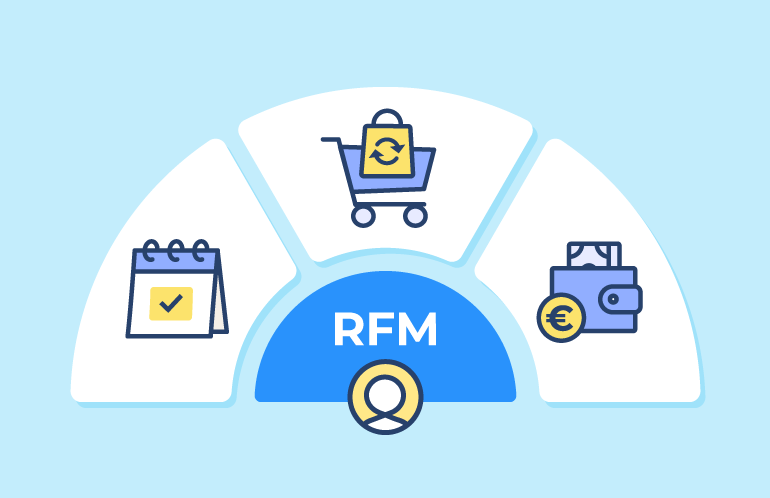How to increase customer value with RFM segmentation?


Category: Data
RFM segmentation clearly represents a formidable growth lever for customer marketing teams in retail and e-commerce.
It is calculated on the basis of the purchase history of active customers and takes into account from a given period :
Based on these three criteria, it scores customers, segments them according to their purchasing behavior and accompanies them through their life cycle:
Other segment categories are of course possible, such as new customers, inactive customers, web shoppers...
RFM segmentation is also an analysis method used to increase customer knowledge in order to better address them, especially when your segmentation marketing automation tool is coupled with a Customer Data Platform.
How can you make the most of RFM segmentation in retail? Here are 5 use cases to support the customer lifecycle.
RFM segmentation enables the customer base to be divided into different segments based on recent purchasing behavior, frequency of purchase and total amount spent. This enables the CRM manager to better understand the different types of customer and tailor marketing strategies to these segments.
Use case: using segments to reduce marketing pressure
RFM segmentation makes it possible to refine the target audience for communications, and consequently reduce marketing pressure. For example, exclude the least engaged segments from certain weekly campaigns to prevent them from unsubscribing, and conversely add more marketing pressure on the most engaged segments to encourage them to buy more often.
By understanding customers' buying habits through RFM segmentation, CRM managers can personalize communications and offers to meet the specific needs of each segment. For example, the most loyal customers can receive exclusive loyalty offers, while inactive customers can be targeted with special incentives to encourage them to return.
Use case: personalizing promotional offers
Retailers can use RFM segmentation to personalize their promotional offers. The most recent and frequent customers, who have also spent large amounts, receive exclusive offers, benefits (private sales before the sales, in-store advantages...) and larger discounts to reward them for their loyalty. On the other hand, less active customers receive special invitations, such as best-sellers or entry-level products, to encourage them to make a new purchase.
By targeting the most valuable customer segments and tailoring messages and offers accordingly, CRM managers can optimize the return on investment of their marketing campaigns. This maximizes the effectiveness of marketing spend by concentrating resources where they will have the greatest impact. By leveraging RFM segmentation, CRM managers can, for example, develop automated scenarios to boost performance.
Use case: optimizing paid campaigns
Using RFM segmentation, a brand can send targeted email campaigns with product recommendations based on customers' previous purchases, increasing the chances of conversion and improving click-through rates.
Brands can also use RFM segmentation to target online advertising campaigns (Ads). Ads are delivered to different customer segments based on their buying behavior, optimizing ad spend by targeting only those segments most likely to convert. It can therefore be used to optimize acquisition budgets by pushing VIP or new customer segments in Seed on Meta or Google, in order to carry out lookalike acquisition campaigns on more precise and therefore more high-performance segments.
Even more concretely, RFM segmentation can be used to optimize the ROI of paid campaigns, such as SMS campaigns, by reserving them for certain segments in order to reduce volume and costs.
RFM segmentation identifies customers who have stopped buying or whose engagement has waned. By targeting these inactive customer segments with special offers or personalized incentives based on the data collected, CRM managers can work to reactivate them and bring them back into the buying process.
Use case: revive inactives
A retail brand can use RFM segmentation to identify customers who have been inactive for more than six months. It sends them personalized reactivation offers based on their purchase history, such as special discounts on their next purchase or complementary products to stimulate their interest and encourage them to return.
Triggering automatic reactivation scenarios based on segment changes within the RFM segmentation ensures that they are reactivated as soon as possible with relevant content.
By understanding customer buying habits through RFM segmentation, CRM Managers can implement more effective loyalty programs. This can include rewards based on frequency and amount of purchases, as well as exclusive benefits for the most valuable customers.
Use case: a differentiated loyalty program
A restaurant chain segments its customers according to their RFM purchasing behavior. The most loyal and highest-spending customers are enrolled in a loyalty program offering exclusive benefits such as VIP events and special rewards. Less active customers are encouraged to join lower-level loyalty programs with progressive benefits to encourage them to spend more.
In each of these use cases, RFM segmentation enables customer marketers to better understand their customer base and personalize their strategies to maximize campaign effectiveness and improve customer loyalty.
RFM segmentation is a powerful tool for CRM managers, enabling them to better understand their customer base, personalize communications and offers, optimize the ROI of marketing campaigns and work on reactivating inactive customers, all with the ultimate aim of improving customer loyalty and overall company profitability.
Contents